PostgreSQL Comparison Operators
Comparison Operators
Comparison operators, as their name, allows to comparing two values. It Compares strings or numbers for relationships such as equality.
List of Comparison Operators
| Operators | Description |
|---|---|
| < ( less than) | Returns true when the left operand is less than the right operand. |
| > ( greater than) | Returns true when the left operand is greater than the right operand. |
| <= ( less than or equal ) | Returns true when the left operand is less than or equal to the right operand. |
| >= (greater than or equal) | Returns true when the left operand is greater than or equal to the right operand. |
| = ( equal ) | Returns true when the operands are equal but the type of the operands must be same. |
| <> or != ( not equal) | Returns true when the operands are not equal. |
The sample table
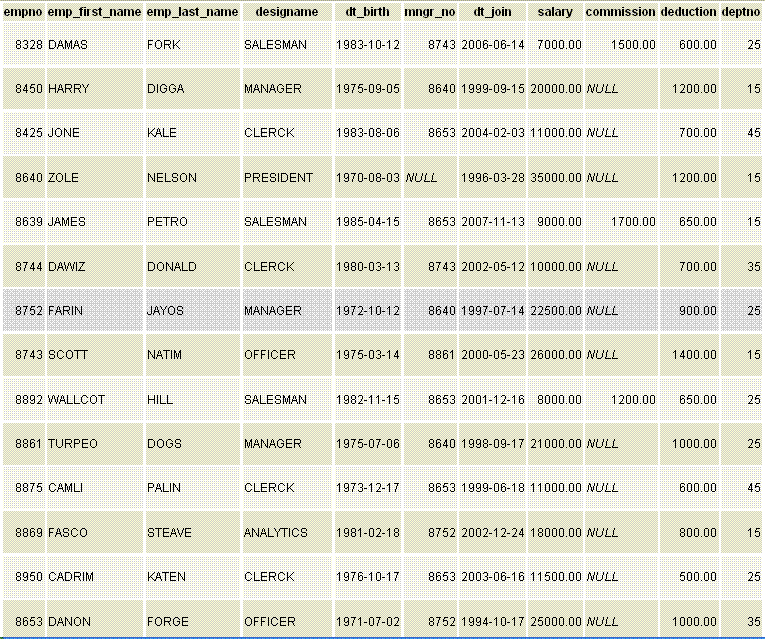
PostgreSQL Less Than ( < ) operator example
If we want to display the list of employees with columns empno, emp_first_name, designame and salary from an employee who drawn the salary amount less than 10000, the following SQL can be used.
SQL
Code:
SELECT empno,emp_first_name,designame,salary
FROM employee
WHERE salary<10000;
Output:
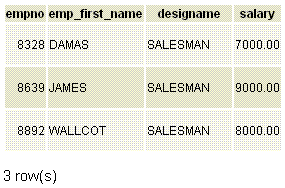
PostgreSQL Greater Than ( > ) operator example
If we want to display the list of employees with columns empno, emp_first_name,designame and salary from an employee who drawn the salary amount more than 18000, the following SQL can be used.
SQL
Code:
SELECT empno,emp_first_name,designame,salary
FROM employee
WHERE salary>18000;
Output:
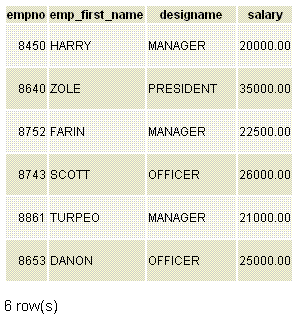
PostgreSQL Greater Than or Equal( >= ) and Less Than or Equal( <= ) operator example
If we want to display the list of employees with columns empno, emp_first_name, emp_last_name,designame and dt_birth from an employee who born between the period 1975-01-01 and 1982-03-31, the following SQL can be used.
SQL
Code:
SELECT empno,emp_first_name,emp_last_name,designame,dt_birth
FROM employee
WHERE dt_birth>='1975-01-01'
AND dt_birth<='1982-03-31';
Output:
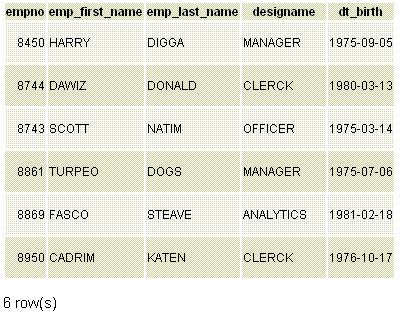
PostgreSQL Equal ( = ) operator example
If we want to display the list of employees with columns empno, emp_first_name, emp_last_name and designation from employee table whose designation is 'CLERCK', the following SQL can be used.
SQL
Code:
SELECT empno,emp_first_name,emp_last_name,designame
FROM employee
WHERE designame='CLERCK';
Output:
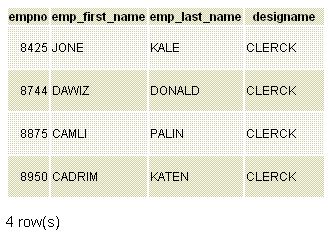
PostgreSQL Not Equal (<> or != ) operator example
If we want to display the list of employees with columns empno, emp_first_name, emp_last_name and designation from employee table who does not belong to the designation 'CLERCK' and 'SALESMAN', the following SQL can be used.
SQL
Code:
SELECT empno,emp_first_name,emp_last_name,designame
FROM employee
WHERE designame<>'CLERCK'
AND designame<>'SALESMAN';
Output:
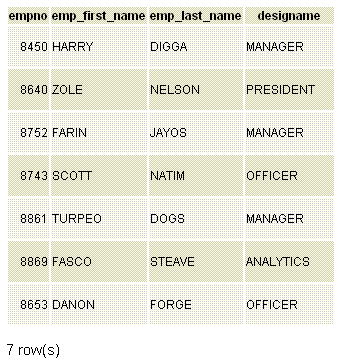
Previous: Logical Operators
Next: Mathematical Operators
